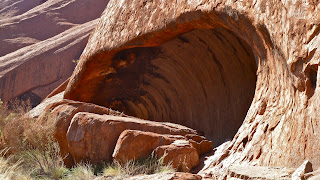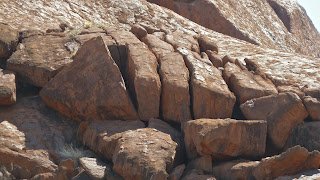Anangu appeal to your better judgement; all signs and info panels politely ask you not to; the Park rangers strongly advise against it. Yet selfish tourists indulge themselves, risking accident or heart attack, compromising the safety of rangers and rescue services, every year. Their footprints scar the Rock, and their actions offend a majority.
The main reason not to climb is a cultural one. Uluru is spiritually significant to Anangu people, relating to their Mala ancestors. As visitors on their land, we don't need to know the detail; just show respect. There are other ways of experiencing Uluru: try walking around it.
Safety is another reason. More than 35 people have died on Uluru. The climb is physically demanding, especially in hot weather. Heat exhaustion and dehydration are serious risks. When rangers have to climb, they must first undergo a fitness check.
Environmentally, climbing is a big no-no. The tramping erodes the rock. Obviously there are no toilet facilities at the top, which doesn't stop people relieving themselves. There is no soil to dig a hole: when it rains, things get washed off the top. Bacteria including E. coli have been found in waterholes at the base of Uluru.
I read a while ago of a tentative agreement to stop people climbing the Rock once and for all when the percentage of tourists doing so dropped below 20. It fell at one point to 17 per cent, I believe, but the climbing continues. I have tried to get hold of up-to-date figures (see Post script below). Greater numbers of Japanese tourists climb than any other nationality; and Japan is an important source of
tourist revenue for Australia. This video from 2013 makes the key points: http://www.theguardian.com/world/2013/jul/09/people-still-climbing-uluru-closure.
The walk is often closed, with little or no notice, for a variety of reasons: high temps, strong winds, the threat of rain or storm, low cloud, a slippery surface… If I were the Park rangers, I'd close it more and more frequently, on one pretext or another. Nobody would be any the wiser.
Many visitors walk only a little way from the Mala car park in one direction or another: the Mala Walk clockwise as far as Kantju Gorge, 2 km return; or the Lungkata Walk anticlockwise as far as Mutitjulu Waterhole, more than twice as far. Both Gorge and Waterhole are well worth seeing. Alternatively, you can park in the Kuniya car park and walk to the Waterhole, only 1 km return. All are grade 1.
The Base Walk is a 10.6 km loop, but add to that the distances into the Gorge (850 metres return) and the Waterhole (roughly 500 metres return) if you want to see them. It's classed as grade 3, moderate, but I'm not sure why. The path is mostly flat and even. I did find it tiring, however; perhaps because it's gravelly or sandy in places rather than smooth. The suggested walking time is 3.5 hours, presumably without many stop-starts. We walked clockwise from the Mala car park and it took us just over four hours – with many stops.
First, the geology. Uluru and Kata Tjuta lie in the Amadeus Basin, a large depression in the earth's crust formed many hundreds of millions of years ago in this region of Central Australia. Extremely thick layers of sediment were laid down in the Basin as water flowed off ancient ranges, depositing material in large fan shapes. Both Uluru and Kata Tjuta had their origins in these alluvial fans. One fan was mainly composed of sand (Uluru); the other was more rocky (Kata Tjuta). Periodically, the Amadeus Basin would be inundated by a shallow sea, when sand mud fell to the bottom, burying the fans. Eventually, the great thickness of sediment compressed and compacted the fans into rock such as sandstone and conglomerate. Between about 400 and 300 million years ago, the region was subjected to mountain-building forces that folded and tilted these sedimentary rocks, the sandstone by as much as 90 degrees. Folding and faulting was followed by erosion of the softer overlying deposits that eventually revealed parts of the fans. Much more recently, since about 30,000 years ago, and in a drier climate, the area has been covered by wind-blown sand, forming plains and dunes. Below is a useful diagram from the National Park Notes I picked up on my first visit.
Uluru is composed of arkose, a coarse sandstone consisting of sand and gravel grains, slightly larger granules, and, less commonly, small pebbles, which gives the Rock a speckled appearance. Its flaky surface is the result of weathering by water and oxygen in the air which chemically decompose certain minerals in the rock. As large-scale overlying sedimentary deposits were worn away, the release of pressure created curved fractures in places through Uluru: these are topographic joints. In places they make the surface of Uluru peel off, creating its rounded form.
Among Anangu people, the Rock's features are explained in creation stories, known as Tjukurpa, about ancestral beings and creatures who journeyed to Uluru and the events that followed. The Cultural Centre describes these traditional stories and the ancient laws and moral system that evolved from them.Walking from the Mala car park, you soon reach some impressive caves, including Malaku Wilytja, the Wave Cave. Wave caves were at first believed to have been created by sand erosion, but are now thought to have been crafted by chemical weathering and water erosion.
A kilometre or so past the caves is Kantju Gorge. Traditionally, it is a place for quiet contemplation, but that wasn't possible when we were there. A ranger-led tour had managed to completely fill the inner sanctum. The ranger was detailing the reasons why people shouldn't climb, which was good, but he could have done that elsewhere. We couldn't get to the waterhole, or sit peacefully with our thoughts, and the only photographs possible were of high parts of the walls above people's heads.
I don't know what this plant is: I noticed it first from The Ghan. Its branches curve towards each other as they grow. I think it would make a pretty good broom.
At the easternmost point of Uluru, the lower part of the slope is much less steep.
The height at which the angle of slope changes coincides with caves here and on the southern side, well above the surrounding plain. There were interesting rock details here.
And lovely views as we continued round.
In fact, there was no end to them…
Then we came to Mutitjulu Waterhole, where rainwater flowing off the top of Uluru has sculpted a series of stepped plunge pools down the mountain.
Beyond the walk to the Waterhole was a fine example of a native fig and a piece of sandstone that has sliced off the main rock face along a vertical fracture, a relatively recent event, some tens of thousands of years ago. The 'newly' exposed rock face hasn't become flaky yet.
We were just about done: one more large view, a small detail, striking trackside flowers and a tantalising glimpse of tomorrow's objective. Then back to the Resort for an early supper before our 'Astro Tour'. Just when we thought we'd seen the spectacular, we peered for an hour or so into a reflecting telescope with 100x magnification, at distant wonders such as globular clusters; double and triple star systems; yellow, blue and rainbow stars; and Saturn's rings.
Post script It took me three attempts to get the Uluru-Kata Tjuta National Park administration to engage with me on this subject. Eventually, a Parks Australia spokesperson explained that they have installed climb counters to obtain more 'robust' numbers, but it is too early to extrapolate. She reported that they have seen fewer climbers year on year since 2010, and they guestimate the figure is currently about 20 per cent. The number must fall to below 20 per cent of visitors to meet one of three criteria for closure of the climb under the current management plan of the Board of Management. The others are that the climb must not be the major reason why people visit Uluru; and 'a range of new experiences' must be in place as alternatives to the climb. There is currently no time-frame within which the climb will be closed, and the Board of Management have promised the tourism industry at least 18 months' notice.
At no point when I was there did anyone ask me my main reason for visiting, so I cannot imagine how criterion number two will be determined. Had anyone enquired, I would simply have listed 'the landscape'. Am I unusual in requiring no new experiences in addition to soaking up extraordinary country?
The climb is seen by many, I believe, as a physical challenge. The Base Walk or bicycle riding round the Rock may not be perceived by some to be demanding enough. I would therefore suggest that the Larapinta Trail is publicised more. The whole trek, and certain sections in particular, require an excellent level of fitness, especially cardiovascular and endurance-based fitness.



















































No comments:
Post a Comment